 |
 |
| 品野工房めぐり Visit to Kilns at Shinano area in Seto City [Photos taken on Apr.19, 2003] |
| 2003年4月19日品野陶磁器センターで散歩地図のパンプレットを貰って、 第2回品野工房めぐり《4月19日(土) 9時〜17時; 4月20日(日)9時〜16時》 へ参加し、2時間位で今回参加窯元10箇所の内、3個所と品野台小学校の登窯 を見て来ました。 当日13時30分から瀬戸市文化センターで催される「オールドノリタケの魅力」と 題する記念講演会を聴く為、余りじっくり見学できなかったので来年は花見も兼ね、 ゆっくり見学しようと思います。 瀬戸市の中心からやや外れた(と言っても車で10分位)赤津地区、水野地区、 品野地区に陶芸作家などの窯元が集中していますが、一般の観光客は交通の便 などで、つい瀬戸市の中心街の陶磁器問屋さん等を見学され、「瀬戸はこんなものか」 と思って帰られるのではないでしょうか。 窯元さんへの要望: 陶都として陶器・陶磁器をより理解して頂く為にも、各地区の窯元が普段の日でも 一般の客に気軽に立ち寄ってもらえるように配慮し、その趣旨を国内外に情報発信 をしてほしい。 After receiving a pamphlet of map for walking at Shinano Ceramic Center in the morning on April 19, 2003, I went to "the 2nd Visit to Kilns at Shinano area" 《9:00 - 17:00 on April 19 (Sat) ; 9:00 - 16:00 on April 20 (Sun)》. For about 2 hours, I visited 3 potteries among 10 and a Noborigama-kiln (or climbing kiln) at Shinanodai primary school. To listen to a memorial lecture meeting, "Charm of Old Noritake" held at Seto City Culture Center at 13:30 on this day, I had not enough time to spend visiting potteries. So, I will visit here again next year partly for the visit and partly for seeing the cherry blossoms. Akazu, Mizuno and Shinano areas are a little away from downtown Seto (only 10 minutes drive's distance). In these three areas, many potteries of ceramic artists are concentrated. I am afraid if ordinary tourists may visit only wholesalers of ceramics at the downtown without visitiing the said potteries for conveniece of transportation and if they will not have a proper understanding of Seto. Request to potteries at Seto: I request that potteries in Seto City should make an arrangement so that ordinary tourists will be able to stop by the potteries light heartedly any time except for holidays and understand more properly on pottery and porcelain. I hope the potteries will send information to the same effect both to foreigners as well as to Japanese. I think the above will be a kind of responsibility of the potteries who live in Seto, the capital of ceramics in Japan. |
| 窯元付近の川 River near potteries |
徳寿製陶所 ガス窯を開いた所 Tokuju Seitojo Gas kiln just opened |
生宝陶苑 釉薬 焼成後 Seiho Toen Glazing agent After firing |
|
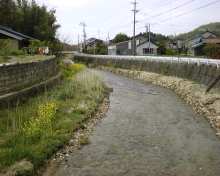 |
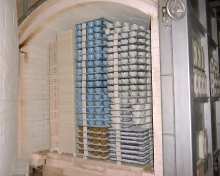 |
|
|
素地は耐火性陶土
- ご子息(加藤氏) |
|||
| 昭泉製陶所 右のカップ成形体験 Shosen Seitojo Experience of forming cup |
練り込み
|
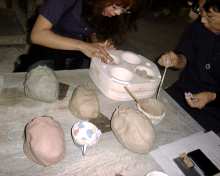 |
|
 |
朱金釉の一輪挿し 釉薬成分:福島長石を主とし酸化チタン(→金色発色)ベンガラ (紅柄→茶色発色)朝鮮カオリン等。 Single flower vase with vermilion gold glazing Glazing agent: Fukushima-feldspar (main agent), Titanium oxide (Golden coloring), Bengala (brown coloring), Chosen-kaolin, etc. |
| 品野台小学校の登窯(左→正面、中→側面、右→背面) Noborigama (climbing kiln) at Shinanodai primary school (left→front view, middle→side view, right→rear view) |
ピザを焼く窯 Pizza-burning kiln |
||
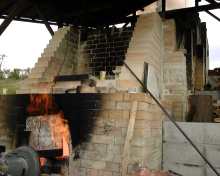 |
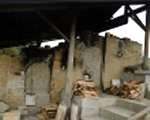 |
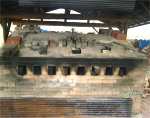 |
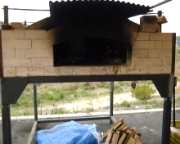 |
| 昭泉製陶所 Shosen Seitojo |
宝山製陶所 Houzan Seitojo |
ビューティー工芸シノダ Beauty Craft "Shinoda" |
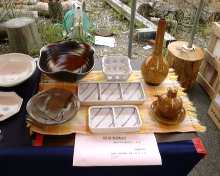 |
 |
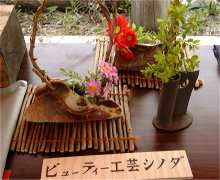 |
| 嶋田窯 Shimada Gama |
丸久製陶所 Maruhisa Seitojo |
秋山製陶所 Akiyama Seitojo |
 |
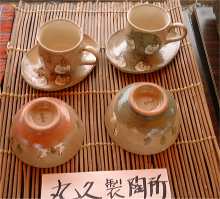 |
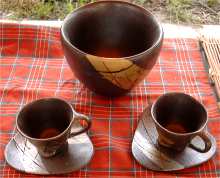 |
| 城山窯 Shiroyama Gama |
角平製陶所 Kadohira Seitojo |
徳寿製陶所 Tokuju Seitojo |
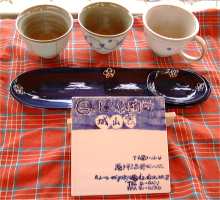 |
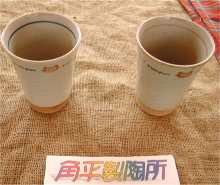 |
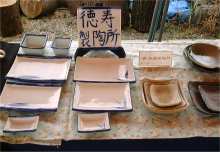 |
| 春花陶器 Shunka Touki |
伊里製陶 Iri Seito |
山田工芸 Yamada Craft |
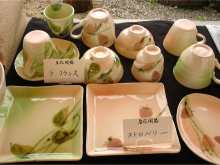 |
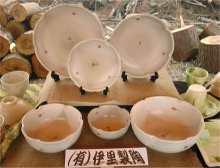 |
 |
| 陶翠窯 Tousui Gama |
生宝陶 Seiho Toen苑 |
初平窯 Hatsuhira Gama |
 |
 |
 |
| 【注】 1 窯元等の紹介 上記写真で背景が黄色で塗られているのは品野台小学校のグランドに展示 されている作品の窯元等の名前です。 2 練り込み陶芸作品 − 下記は1956年瀬戸市に生れ各種陶芸展で入選された 陶芸家長江氏作成の説明板より引用: 練り込みは2種類以上の発色の異なる粘土を練り合わせ模様を作る装飾の 技法で練上手・ウズラ手とも呼ばれる。これは、中国の唐の時代に始められ 宋の磁州窯の作品には、練り込みによる皿や鉢などが見受けられる。その 製法は、粘土の練り合わせ練り合わせ具合によって単純な模様から極めて 複雑なものまで、様々な模様が出来る。 このような練上げ技法を用い、土の 温かさを重ねて、独特の美しさを表現し続けて生きたい。 【Note】 1 The name of potteries are shown on the cells which backgrounds are painted in yellow. The work of the potteries are exhibited at the playground of Shinanodai primary school, Seto City. 2 Work of ceramic art by kneading (The following explanation is quoted from the explanation board made by Mr. Nagae; He was born in Seto City in 1956 and has been accepted by various ceramic art exhibition.)) Kneading is the technique of the ornament to make a pattern after kneading two or more kinds of china clay with different coloring. This technique is also called Neading skill or Uzura hand. This started in the era of Tang, China. (618-907). Plates or bowls with the technique are found in the work made at the "Jishu-kiln" in the era of So, China (960-1279). When using this technique, you will be able to make various patterns from simple to complicated ones. I like to continue expressing the unique beauty by piling the warmth of the china clay. |